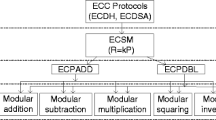Abstract
The increasing threat to data over public channels has bought about a need to secure sensitive data to avoid its misuse and tampering. This makes data security an important issue in the present which will continue to pose a problem in the future.
Over the successive years a lot of work has been done in this field, with the recent developments focusing on neural networks and its application in security. Neural network algorithms for the same like Multilayer Perceptron technique, Back Propagation Technique have been implemented. Multilayer Perceptron technique aforesaid model lacks in accuracy and is complex whereas the Back Propagation Technique is more accurate but its complexity is more than Multilayer Perceptron and also has result convergence faults.
This paper deals with data encryption using a random set of keys and the key identification using Hebbian learning. Here bits of data are taken at a time and encrypted using a key from given set of keys. The key is identified using Hebbian learning and hence data is decrypted. Main advantage of this method is its simplicity and that it is error free in lossless transmission.
Access this chapter
Tax calculation will be finalised at checkout
Purchases are for personal use only
Similar content being viewed by others
References
Luo, B., Liu, Y.: The risk evaluation model of network information security based on improved BP neural network. IEEE (2012)
Fu, J., Huang, L., Yao, Y.: Application of BP neural network in wireless network security evaluation. IEEE (2010)
Haykin, S.: Neural networks a comprehensive foundation. MacMillan Publishing Company, New York (1994)
El-Sharkawi, M.A., Huang, S.J.: Development of genetic algorithm embedded Kohonen neural network for dynamic security assessment. IEEE (1996)
Risk modelling (2010). http://www.owasp.org/index.php/Threat_Risk_Modeling. Accessed 24 Sep 2014
Dengguo, F., Yang, Z., Yuqing, Z.: Risk assessment of information security survey. J. China Inst. Commun. 25(7), 10–18 (2004)
Liming, Z.: Artificial Neural Network Model and Its Application. Fudan University Press, Shanghai (1994)
Salek, Z., Madani, F.M., Azmi, R.: Intrusion detection using neural networks trained by differential evaluation algorithm
Author information
Authors and Affiliations
Corresponding author
Editor information
Editors and Affiliations
Rights and permissions
Copyright information
© 2016 Springer Nature Singapore Pte Ltd.
About this paper
Cite this paper
Murmu, B.I., Kumari, A., Malkani, M., Kumar, S. (2016). Key Identifications Using Hebbian Learning. In: Mueller, P., Thampi, S., Alam Bhuiyan, M., Ko, R., Doss, R., Alcaraz Calero, J. (eds) Security in Computing and Communications. SSCC 2016. Communications in Computer and Information Science, vol 625. Springer, Singapore. https://doi.org/10.1007/978-981-10-2738-3_11
Download citation
DOI: https://doi.org/10.1007/978-981-10-2738-3_11
Published:
Publisher Name: Springer, Singapore
Print ISBN: 978-981-10-2737-6
Online ISBN: 978-981-10-2738-3
eBook Packages: Computer ScienceComputer Science (R0)



